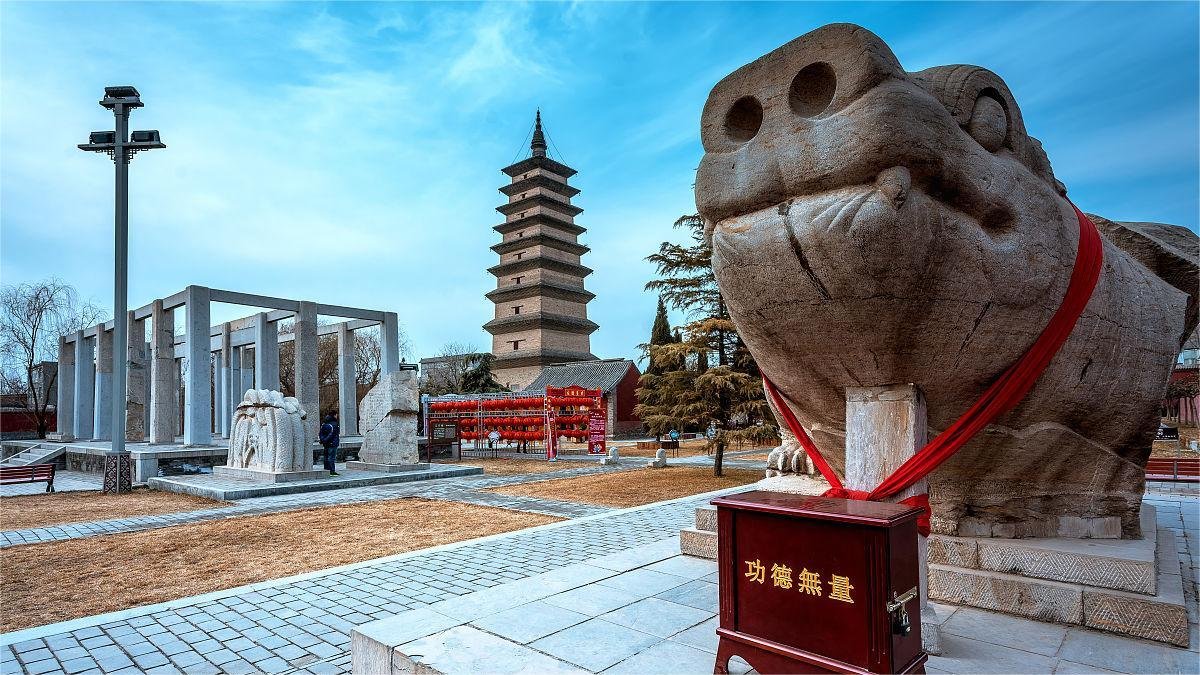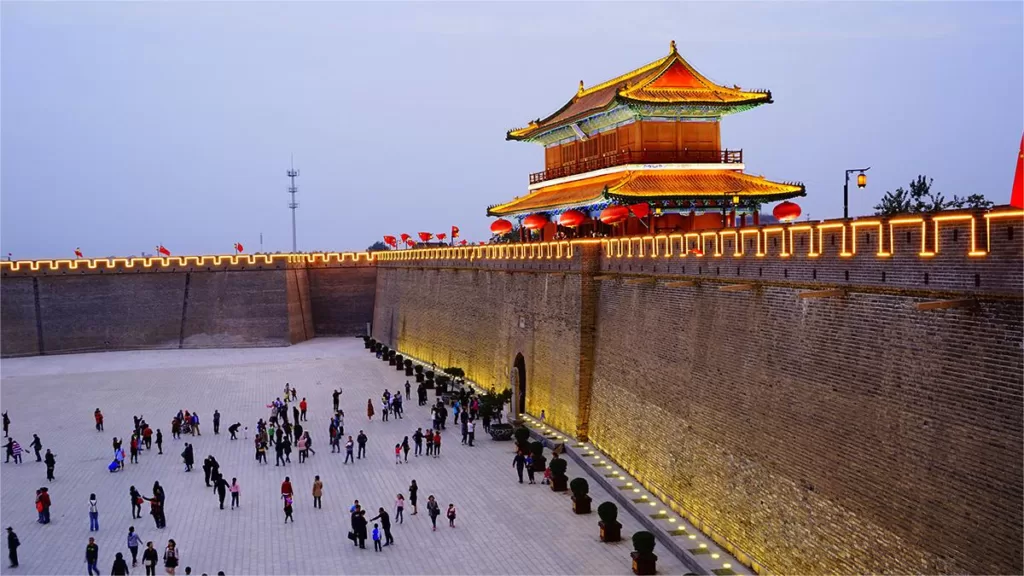Kaiyuan Temple (开元寺), located in Zhengding County, Shijiazhuang, is a venerable Buddhist sanctuary with a rich history dating back to 540 BC during the East Wei Dynasty. Originally known as Jingguan Temple, it has stood as a testament to spiritual devotion for centuries. In 738, during the Tang Dynasty, it was aptly renamed Kaiyuan Temple to align with the reigning title of the era.
This sacred complex boasts a harmonious and symmetric layout that reflects the classic architectural style of the Tang Dynasty. Visitors are greeted by a magnificent triple-gate tower that leads to an array of meticulously designed structures, including Tianwang Hall, Xumi Pagoda, Bell Tower, and Fachuan Hall. Each of these buildings is steeped in historical and cultural significance, making Kaiyuan Temple a profound destination for both spiritual seekers and admirers of ancient Chinese architecture. It stands as a living testament to the enduring legacy of Buddhism and the artistic excellence of the Tang Dynasty.
Table of Contents
- Basic Information
- Location and Transportation
- Highlights of Kaiyuan Temple
- A Brief History of Kaiyuan Temple
- Other Attractions in Zhengding County
Basic Information
| Estimated Length of Tour | 0.5 – 1 hour |
| Ticket Price | 20 RMB |
| Opening Hours | 8.30 – 17.30 (Monday – Thursday) 8.30 – 21.30 (Friday – Sunday) |
| Telephone Number | 0086-0311-88018545 |
Location and Transportation
Kaiyuan Temple is situated in Zhengding County, which is a county-level city within the jurisdiction of Shijiazhuang, the capital city of Hebei Province in northern China. Zhengding County is renowned for its historical and cultural significance, and it’s approximately 15 kilometers (9 miles) north of Shijiazhuang’s city center. The temple’s exact address is No. 109, Yanzhao South Avenue.
To get there, tourists can take bus 136, 150, or 152 and get off at Kaiyuan Temple Stop (开元寺站).
Highlights of Kaiyuan Temple
Xumi Pagoda

The Xumi Pagoda, situated within Kaiyuan Temple, is a revered structure steeped in Buddhist symbolism and history. Its name, “Xumi,” originates from a divine mountain in India believed to be at the center of the world according to Buddhist texts. Erected in 636 BC, this rectangular pagoda soars to a height of 39.55 meters. Its architectural style draws parallels to the iconic Giant Wild Goose Pagoda in Xi’an, characterized by a simple and rustic aesthetic. Notably, the pagoda’s front door frame is intricately adorned with exquisite engravings of vases, flowers, and dragons, adding an ornate touch to its otherwise understated elegance.
Bell Tower

Kaiyuan Temple’s Bell Tower, a striking architectural gem, stands in opposition to the Xumi Pagoda. Rising 14 meters tall, this tower is a testament to the artistry of bricks and wood craftsmanship. At its core, the first floor houses a well, and directly above it, a resplendent bronze bell graces the tower. Its historical roots run deep, with the tower’s base dating back to the Tang Dynasty, providing a sturdy foundation for the upper structures that were added during the Qing Dynasty. This harmonious blend of historical epochs and elegant design makes the Bell Tower an integral and captivating part of Kaiyuan Temple’s rich heritage.
Ancient Bell

Nestled within the tranquil precincts of Kaiyuan Temple, an ancient bell resonates with the echoes of history, its origins tracing back to the illustrious Tang Dynasty. Standing at a commanding height of 2.9 meters and boasting a bore size of 1.56, this venerable bell exudes a rustic and unadorned charm. Remarkably, its surface remains devoid of any inscriptions or carvings, enhancing the air of mystique that surrounds it. With each resonant toll, it carries visitors back in time, inviting contemplation and reverence for the enduring spiritual and cultural heritage that Kaiyuan Temple embodies.
Giant Stone Bixi

Discovered in the year 2000 within the sacred confines of Kaiyuan Temple, the Stone Bixi (赑屃) stands as a remarkable relic from the Five Dynasties era. Crafted in the likeness of the mythical creature Bixi, believed to be the sixth son of the dragon, it possesses the form of a majestic turtle. This colossal stone, measuring 8.4 meters in length, 3.2 meters in width, and 2.5 meters in height, commands attention and respect. Astonishingly, it weighs a staggering 107 tons, and, in its role as a revered base for steles, it not only supports ancient inscriptions but also carries the weight of history and tradition within Kaiyuan Temple.
A Brief History of Kaiyuan Temple
Kaiyuan Temple, originally named Jingguan Temple, was founded in 540 during the Eastern Wei Dynasty. In 591, it was renamed Xiehui Temple. During the reign of Empress Wu Zetian in 690, following the Dayun Sutra, the temple was renamed Dayun Temple, as similar temples were built across the empire.
In 738, during the Tang Dynasty, it was renamed Kaiyuan Temple. The temple underwent significant expansions over the centuries, with a bell tower constructed in the late Tang period. A Ming Dynasty stele from 1600 records the temple’s layout, which included a front gate, Pilu Pavilion, halls for monks and visitors, the Kaiyuan Bell Tower, a brick pagoda, and the main Dharma Hall. The temple covered approximately 9,000 square meters.
Kaiyuan Temple saw extensive renovations under the Tang, Ming, and Qing dynasties, but by the late Qing period, much of the temple had been lost. Only the brick pagoda, bell tower, and Dharma Hall remained. During the Republican era, it was repurposed for use as a police training center and a county hospital. By the mid-20th century, only a few structures survived.
In 1966, the Dharma Hall was destroyed. In 1980, large-scale restoration efforts began. The temple’s remaining stone relics were moved to Longxing Temple for preservation. In 1989, the bell tower underwent a major restoration, ensuring the preservation of this historic Buddhist site.








At the Bixi Satue inside, which is the heaviest stele in the country weighing 107 tons; there is a Tang pagoda (Xumi Pagoda), a Tang bell tower, with the base of the tower dating back to the Tang dynasty and the facade being restored in the Qing dynasty. You can see the bell, but you can’t ring it. The original main hall (Fachuan Hall) is destroyed, leaving only a site. Now behind the pagoda and bell, there is a small… Read more »